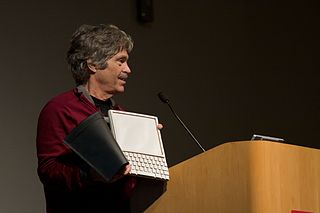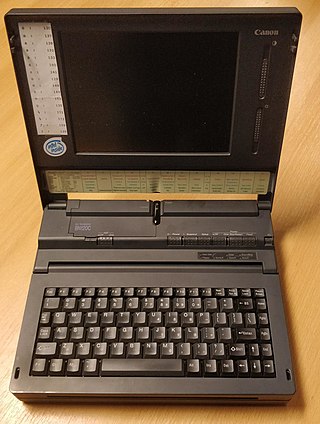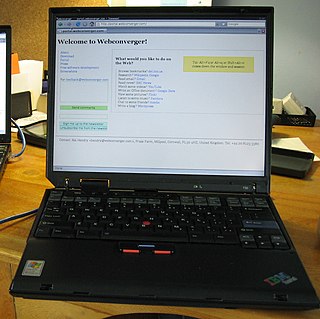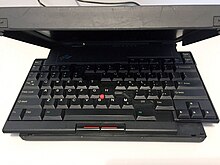
ThinkPad is a line of business-oriented laptop and tablet computers produced since 1992. The early models were designed, developed and marketed by International Business Machines (IBM) until it sold its PC business to Lenovo in 2005; since 2007, all new ThinkPad models have been branded Lenovo instead and the Chinese manufacturer has continued to develop and sell ThinkPads to the present day.

A pointing stick is a small analog stick used as a pointing device typically mounted centrally in a computer keyboard. Like other pointing devices such as mice, touchpads or trackballs, operating system software translates manipulation of the device into movements of the pointer on the computer screen. Unlike other pointing devices, it reacts to sustained force or strain rather than to gross movement, so it is called an "isometric" pointing device. IBM introduced it commercially in 1992 on its laptops under the name "TrackPoint", and patented an improved version of it in 1997. It has been used for business laptops, such as Acer's TravelMate, Dell's Latitude, HP's EliteBook and Lenovo's ThinkPad.

Subnotebook, also called ultraportable, superportable, mini notebook or mini laptop, is a type of laptop computer that is smaller and lighter than a typical notebook-sized laptop.

IdeaPad is a line of consumer-oriented laptop computers designed, developed and marketed by Lenovo. The IdeaPad mainly competes against computers such as Acer's Aspire, Dell's Inspiron and XPS, HP's Pavilion, Envy, Stream, and Spectre, Samsung's Sens and Toshiba's Satellite.

The history of laptops describes the efforts, begun in the 1970s, to build small, portable personal computers that combine the components, inputs, outputs and capabilities of a desktop computer in a small chassis.

The ThinkPad T series is a line of notebook computers manufactured by Lenovo as part of the ThinkPad family. The T series is officially the flagship ThinkPad product, offering high-performance computers aimed at businesses and professionals. The ThinkPad X series was originally introduced in 2000 and was produced by IBM until 2005.

The ThinkPad X series is a line of notebook computers and convertible tablets produced by Lenovo as part of the ThinkPad family. The ThinkPad X series is traditionally the range best designed for mobile use, with ultraportable sizes and less power compared to the flagship ThinkPad T series. It was initially produced by IBM until 2005.

The ThinkPad W series laptops from Lenovo were described by the manufacturer as being "mobile workstations", and suit that description by being physically on the larger side of the laptop spectrum, with screens ranging from 15.6" to 17.3" in size. Most W series laptops offered high-end quad-core Intel Core processors with an integrated GPU as well as an Nvidia Quadro discrete GPU, utilizing Nvidia Optimus to switch between the two GPUs as required. Notable exceptions are the W500, which has ATI Mobility FireGL integrated workstation-class graphics, and the W550s, which is an Ultrabook-specification laptop with only a dual-core processor. The W series laptops offered independent software vendor (ISV) certifications from various vendors such as Adobe Systems and Autodesk for computer-aided design (CAD) and 3D modeling software.
John Karidis was a Greek-American mechanical engineer, inventor, and an Emeritus Distinguished Engineer at the IBM T.J. Watson Research Center. He graduated with BS, MS & PhD, (1976-1983) in Mechanical Engineering from Penn State University.

The ThinkPad Yoga is a 2-in-1 convertible business-oriented tablet from Lenovo unveiled in September at the 2013 IFA in Berlin, Germany. It was released in the United States in November 2013.

The ThinkPad T60 is a laptop that was manufactured by Lenovo and marketed under the IBM brand.

The IBM Thinkpad 350 series was a notebook computer series introduced in 1993 by IBM as part of their Thinkpad laptop series. It was the successor to the IBM ThinkPad 300. With only 2 models ever made in the series, it was succeeded in 1994 by the IBM Thinkpad 360 series.

The IBM ThinkPad 560 is a notebook series from the ThinkPad line by IBM. It has been argued that the ThinkPad 560 was the first ultraportable notebook.

The ThinkPad 755 is a series of high-end notebook-sized laptops released by IBM from 1994 to 1996. All models in the line feature either the i486 processor or the original Pentium processor by Intel, clocked between 50 and 100 MHz. The ThinkPad 755CD, introduced in October 1994, was the first notebook on the market with an internal full-sized CD-ROM drive. The ThinkPad 755 series was the top-selling laptop for much of 1994, beating out competition from Apple Computer and Compaq. IBM replaced it with the ThinkPad 760 series in January 1996.

The Canon NoteJet is a series of notebook computers which include a printer and scanner that was manufactured from 1993 to 1995 by a joint venture between the Canon subsidiary Canon Computer Systems Inc. and IBM subsidiary IBM Japan. The Canon branded series was sold worldwide except in Japan, where the similar IBM ThinkPad 555BJ and 550BJ was sold. The European model did not use the NoteJet branding and was branded as the Canon BN120C, BN22 or BN200.

The IBM ThinkPad Power Series(800/820/821/822/823/850/851/860) is a laptop series from the ThinkPad line that was manufactured by IBM. It is based on the PowerPC architecture.

The IBM PS/2 Note and PS/note are a series of notebooks from the PS/2 line by IBM. It was announced in March 1992, half a year prior to the release of the first ThinkPad, the IBM ThinkPad 700. The series was discontinued in 1994.

The IBM ThinkPad 220 is a subnotebook from the ThinkPad line by IBM. It was released in Japan only in 1993, and was jointly developed by IBM Japan Yamato Facility and IBM Japan and Ricoh joint project Rios System.

The IBM ThinkPad T30 is a laptop computer manufactured by IBM.

The Lenovo ThinkPad X300 is a discontinued laptop from the ThinkPad line that was manufactured by Lenovo.























